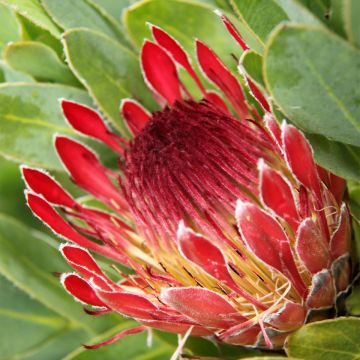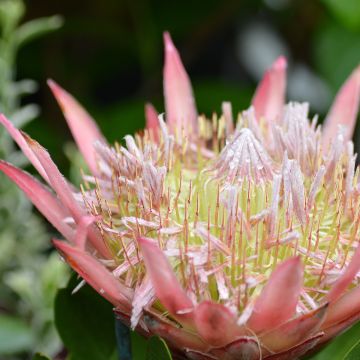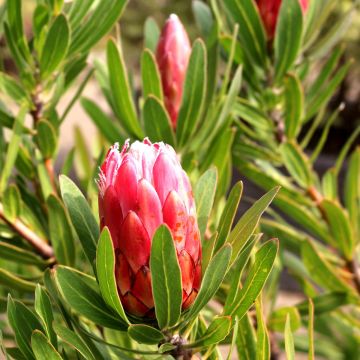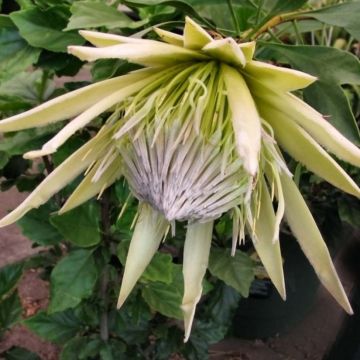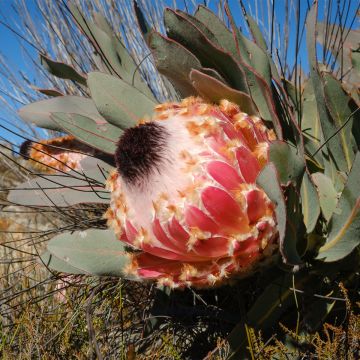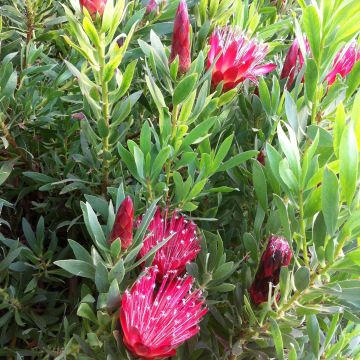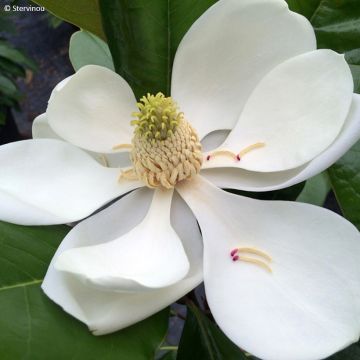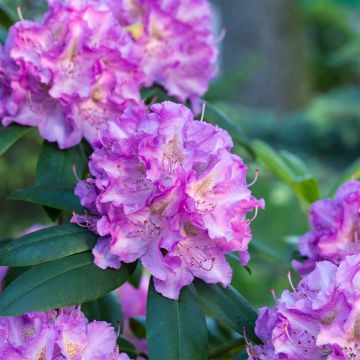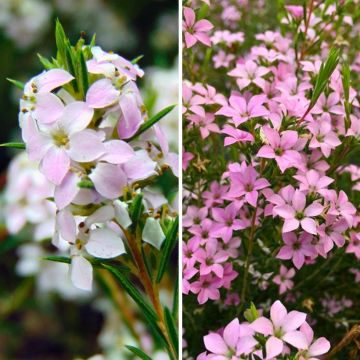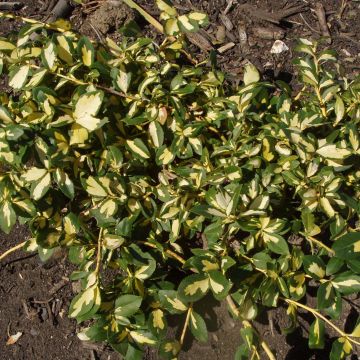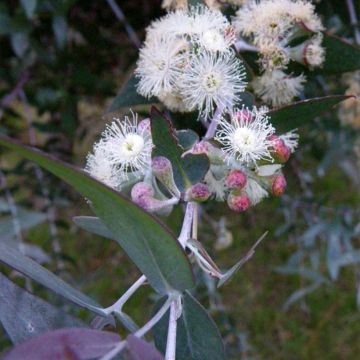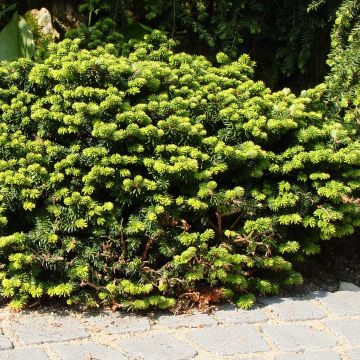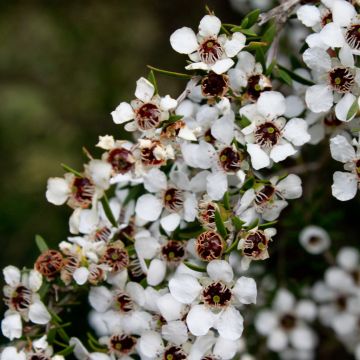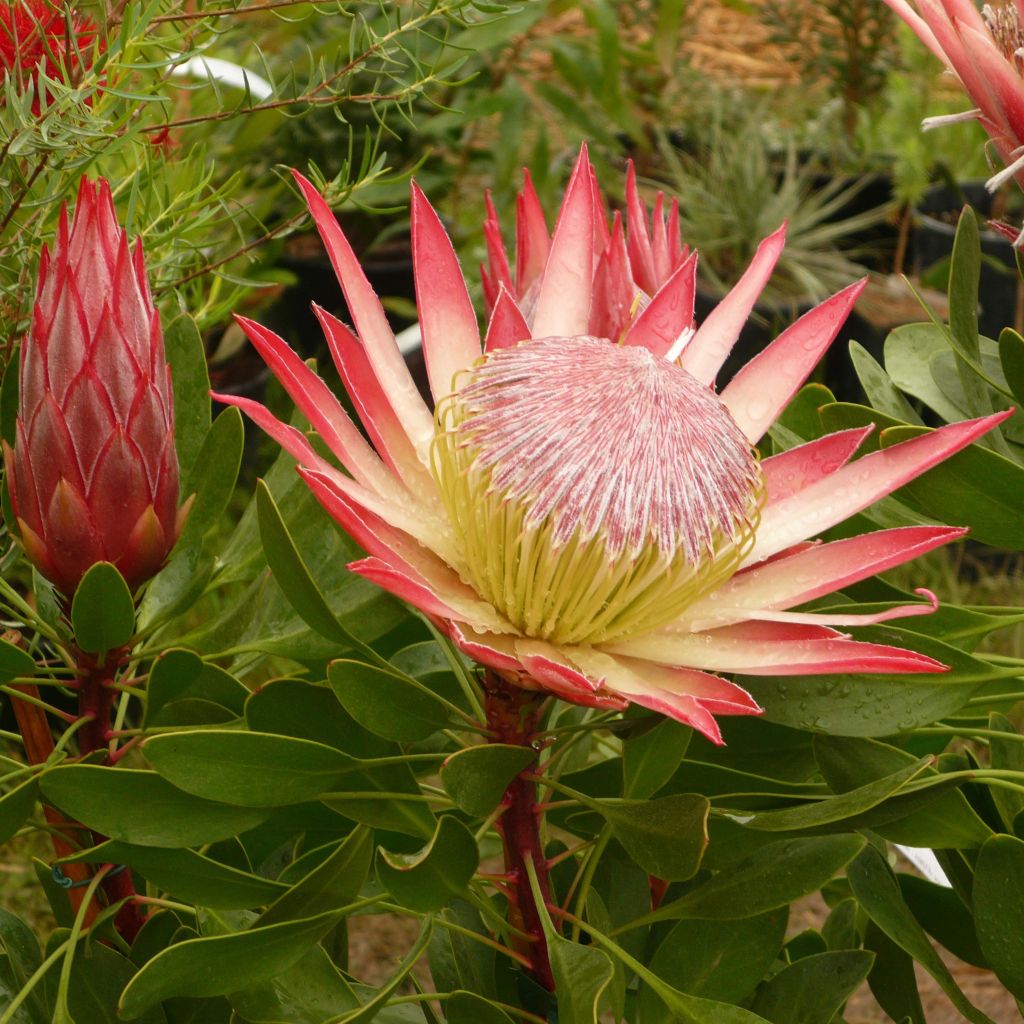

Protea Pink Crown - Protée hybride
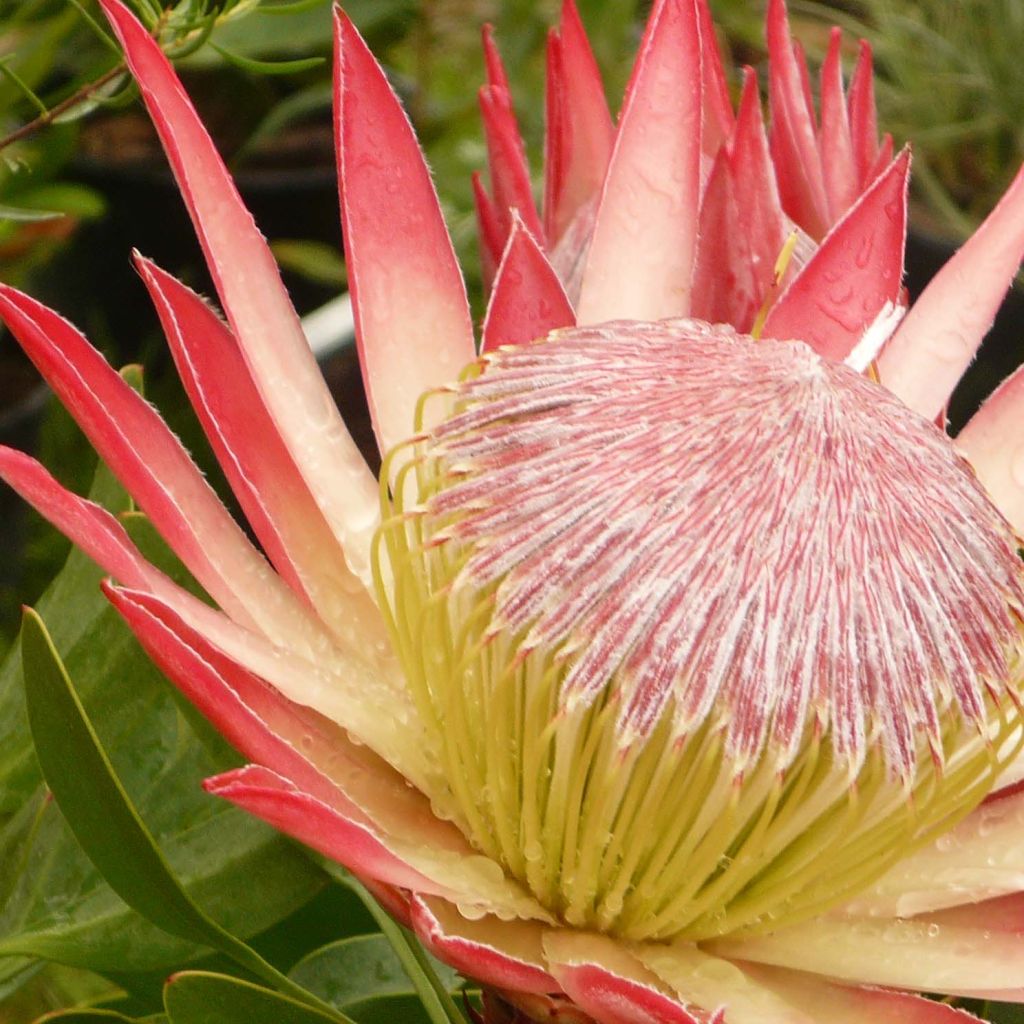

Protea Pink Crown - Protée hybride
Protea Pink Crown
Protea x cynaroides Pink Crown
Hybrid Protea, Protea
This item cannot be shipped to the selected country
Delivery charge from €5.90
More information
Delivery charge from €5.90
More information
Schedule delivery date,
and select date in basket
This plant carries a 24 months recovery warranty
More information
We guarantee the quality of our plants for a full growing cycle, and will replace at our expense any plant that fails to recover under normal climatic and planting conditions.
From €5.90 for pickup delivery and €6.90 for home delivery
Express home delivery from €8.90.
Does this plant fit my garden?
Set up your Plantfit profile →
Description
Protea Pink Crown is a hybrid protea with great ornamental value, whose cultivation requires, like all proteas, a certain know-how. This truly fascinating shrub will be a source of pride of gardeners who love challenges. The floral heads, enormous and shaped like flared cups, evoke well-developed artichokes, where the white of the powdery stamens and the tender salmon pink of the large peripheral bracts blend harmoniously with beautiful, slightly glaucous foliage that resembles that of certain eucalyptus. The flowering, which takes place from spring to winter depending on the climate, is very long-lasting in dry bouquets. Cultivating it in a large pot is preferable, outside the mildest areas of our country, not only to control the composition of the growing medium, but also because it is imperative to protect the plant as soon as the first frosts occur.
The 'Pink Crown' protea is a recent creation, still not widely available in the French horticultural trade. It is a descendant of the Protea cynaroides, a widely distributed botanical species in South Africa, variable in terms of colour and shape, adapted to many mountainous environments. Both are perennial shrubs of the protea family, native to the Cape region in South Africa. Strange in every respect, they require fire for their seeds to germinate.
'Pink Crown' develops multiple thick stems, branching from the base and suckering. It will reach an average height of 1 m (3ft) and slowly spreads over time. It bears long red petioles with alternate, elongated and pointed, tough leaves that have the ability to absorb atmospheric moisture. Flowering occurs from April to October, or even in winter. The inflorescences are large heads, carried at the terminal part of each branch. They measure from 20 to 30 cm (8 to 12in) in diameter. Mature and well-established plants can produce up to ten heads per season. The flower buds resemble magnificent artichokes with pearly scales. The head opens, the white and salmon pink bracts open onto a fluffy cone, white to very pale pink, as if powdered. The flowering attracts many pollinating insects and gives way to a few velvety seeds, almost as large as walnuts. The thick roots of this plant also serve as a storage organ. In case of fire, the protea is capable of regenerating from its roots, fertilised by its own ashes.
The 'Pink Crown' protea is a sensational plant that does not leave anyone indifferent. It will settle well in coastal gardens spared from heavy frosts, in light, poor, not too chalky soil. Particularly adapted to the Mediterranean climate, it thrives in poor, dry to arid soils and will look good when grown as a standalone specimen on large slopes or in the back of dry garden beds, but always in an open position, in full sun. In an exotic garden, it can be associated with Tree Echium or Pride of Madeira, Puyas, Euphorbia characias, Euphorbia mellifera, Giant Fennel, Leucadendrons, Melianthus major, palms (Trachycarpus fortunei, Sabal minor) or hybrid mulleins.
Protea Pink Crown in pictures
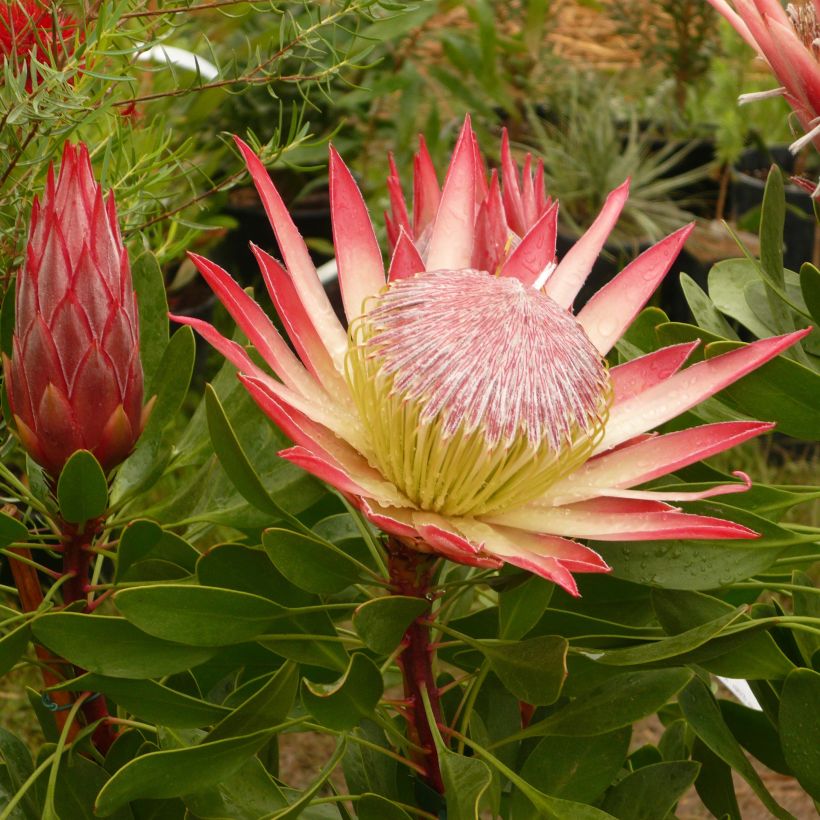

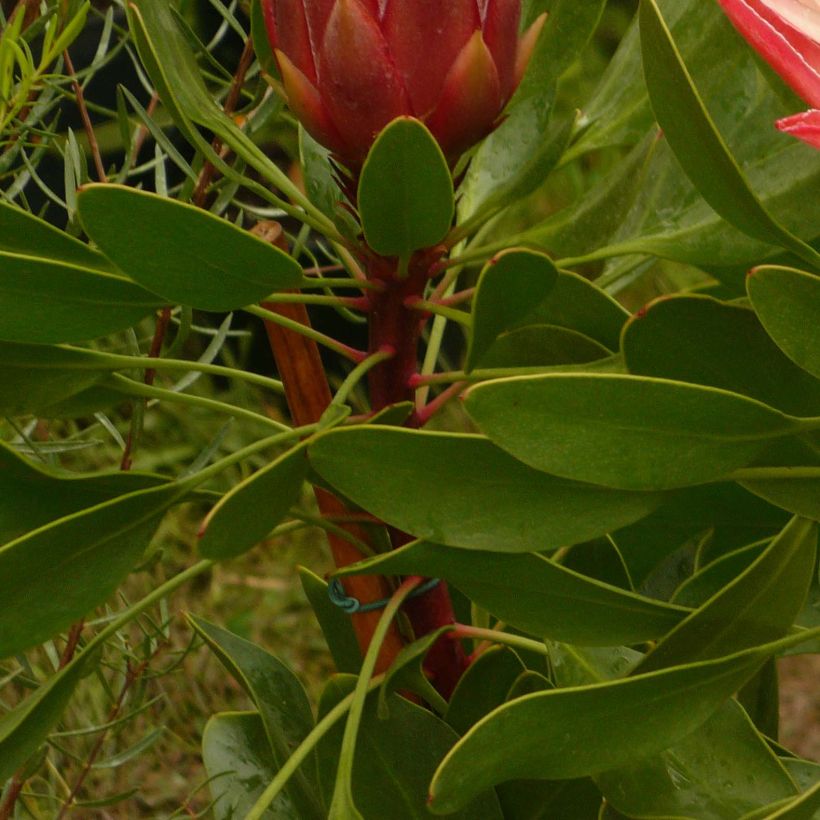

Plant habit
Flowering
Foliage
Botanical data
Protea
x cynaroides
Pink Crown
Proteaceae
Hybrid Protea, Protea
Cultivar or hybrid
Other Protea
Planting and care
Plant 'Pink Crown' protea preferably in spring, or in autumn in mild climates, in a very sunny and sheltered position. This plant requires a light, well-drained, poor, mineral soil with a tendency towards acidity. A mixture including leaf compost, a little bit of ericaceous compost or crushed pine bark, and coarse river sand or perlite is usually appropriate. Proteas are sensitive to excess phosphates and nitrates, so it is important to avoid over-fertilising. While mature plants can tolerate occasional frosts of around -6 °C (21.2°F) in dry soil, young proteas should be protected from frost during their first years, either in a frost-free location in cooler climates or under a protective fleece in regions with mild winters. This plant blooms after approximately 4 to 5 years of cultivation from sowing. For indoor cultivation, it is important to ensure good ventilation in the room and to avoid watering with hard water.
Planting period
Intended location
Care
-
, onOrder confirmed
Reply from on Promesse de fleurs
Evergreen shrubs
Haven't found what you were looking for?
Hardiness is the lowest winter temperature a plant can endure without suffering serious damage or even dying. However, hardiness is affected by location (a sheltered area, such as a patio), protection (winter cover) and soil type (hardiness is improved by well-drained soil).

Photo Sharing Terms & Conditions
In order to encourage gardeners to interact and share their experiences, Promesse de fleurs offers various media enabling content to be uploaded onto its Site - in particular via the ‘Photo sharing’ module.
The User agrees to refrain from:
- Posting any content that is illegal, prejudicial, insulting, racist, inciteful to hatred, revisionist, contrary to public decency, that infringes on privacy or on the privacy rights of third parties, in particular the publicity rights of persons and goods, intellectual property rights, or the right to privacy.
- Submitting content on behalf of a third party;
- Impersonate the identity of a third party and/or publish any personal information about a third party;
In general, the User undertakes to refrain from any unethical behaviour.
All Content (in particular text, comments, files, images, photos, videos, creative works, etc.), which may be subject to property or intellectual property rights, image or other private rights, shall remain the property of the User, subject to the limited rights granted by the terms of the licence granted by Promesse de fleurs as stated below. Users are at liberty to publish or not to publish such Content on the Site, notably via the ‘Photo Sharing’ facility, and accept that this Content shall be made public and freely accessible, notably on the Internet.
Users further acknowledge, undertake to have ,and guarantee that they hold all necessary rights and permissions to publish such material on the Site, in particular with regard to the legislation in force pertaining to any privacy, property, intellectual property, image, or contractual rights, or rights of any other nature. By publishing such Content on the Site, Users acknowledge accepting full liability as publishers of the Content within the meaning of the law, and grant Promesse de fleurs, free of charge, an inclusive, worldwide licence for the said Content for the entire duration of its publication, including all reproduction, representation, up/downloading, displaying, performing, transmission, and storage rights.
Users also grant permission for their name to be linked to the Content and accept that this link may not always be made available.
By engaging in posting material, Users consent to their Content becoming automatically accessible on the Internet, in particular on other sites and/or blogs and/or web pages of the Promesse de fleurs site, including in particular social pages and the Promesse de fleurs catalogue.
Users may secure the removal of entrusted content free of charge by issuing a simple request via our contact form.

































